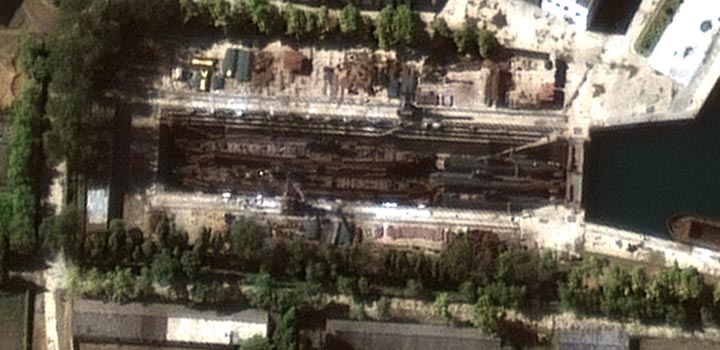Vol. 2, No. 3 - March 2011

A 10 October 2005 DigitalGlobe satellite image showing a single new K-300 SSC (right center)—approximately 39 m long—berthed between two shorter 34 m Sang-o SSC in a dry dock at the Chunghung-man Navy Base on Mayang-do (i.e., Mayang Island). Two Romeo class SS are seen deeper (left) in the dry dock. (DigitalGlobe)
Articles in this issue include,
"KPN Deploys New Version of Sang-o Class Coastal Submarine," by Joseph S. Bermudez Jr.
During mid-March 2011 Republic of Korea officials revealed that the Korean People’s Navy had developed and been operating a small number of new coastal submarines (SSC) for “several years.” These new submarines, tentatively identified as the K-300 class or possibly Sang-o II class, are apparently based upon the older Sang-o class SSC.
"The Korean People’s Air Force in 1953," by Joseph S. Bermudez Jr.
While the Korean People’s Air Force (KPAF) conducted a number of small operations during the opening phases of the Fatherland Liberation War (i.e., Korean War) the intervention of the United Nations Command air power quickly eliminated it as a combat effective force. With the exception of night heckler raids using Po-2 biplanes and Yak-18 trainers and a small number of combat air patrols over northwestern Korea (i.e., “MiG Alley”) the KPAF did not significantly contribute to air combat operations during the remainder of the war due to a decision by Kim Il-sung to allow the Chinese and Soviets to bear the brunt of combat and save the KPAF for the future. During the first nine months of 1953 the KPAF underwent dramatic organizational changes as it began to assume responsibility for the defense of the DPRK.
"The Hydrometeorological Service," by Joseph S. Bermudez Jr.
The Hydrometeorological Service of the DPRK was established during 1946 as “...an organ directly under the authority of the Cabinet.” Today it is responsible for providing the nation with weather forecasts, storm (e.g., typhoons, etc.) warnings, atmospheric monitoring and maintaining “an early warning system” for the “development of the national economy and protection of the lives of the people.” It also provides advanced analytical and monitoring support to the General Staff Department’s Geological, Nuclear-Chemical Defense and Ballistic Missile Training Guidance Bureaus, as well as the Korean People’s Air Force and Navy. Such assistance is especially important during nuclear tests, nuclear accidents (e.g., April 2011 Fukushima nuclear accident), satellite launch attempts, operational planning, etc. It would also be critical for any long-range missile operations during a future conflict.
"Han-gang Bridges," by Joseph S. Bermudez Jr.
The past articles in KPA Journal concerning KPA engineer river crossing units, bridging operations and the Han-gang Bridges continue to generate considerable reader interest. This photo essay provides several additional contemporaneous photographs of the Han-gang bridges.
Additional Material
Editor’s Note and Endnotes are also provided.